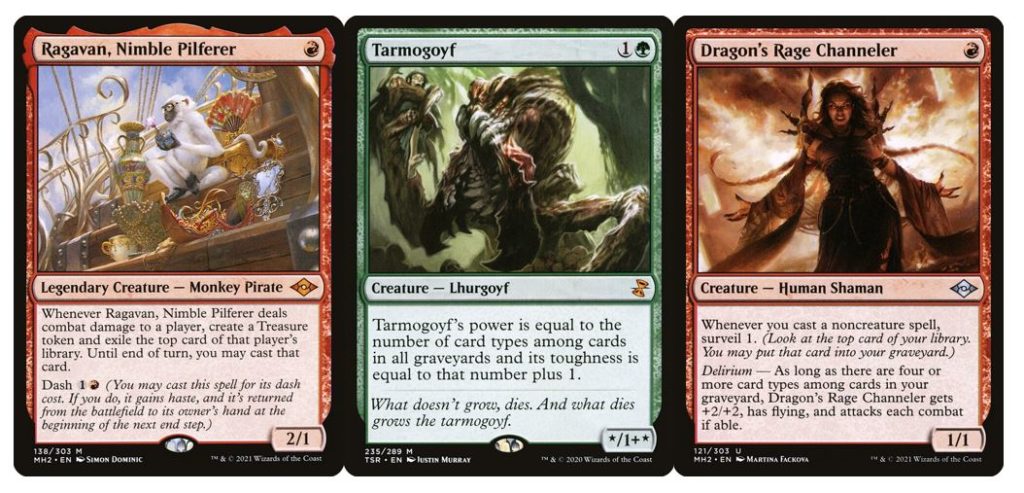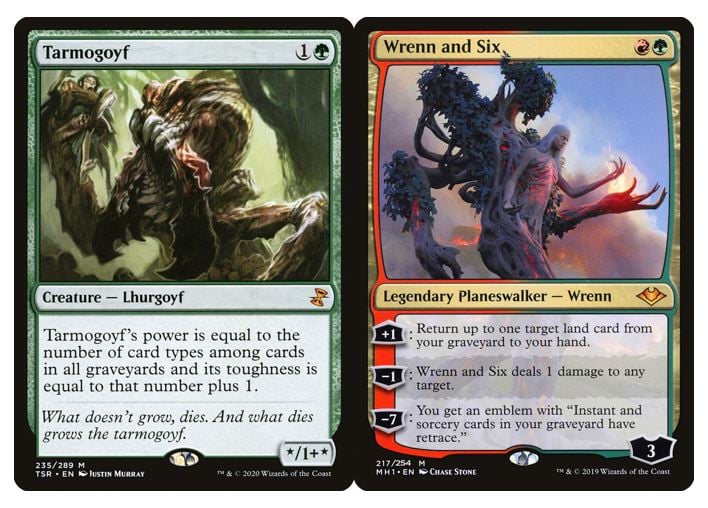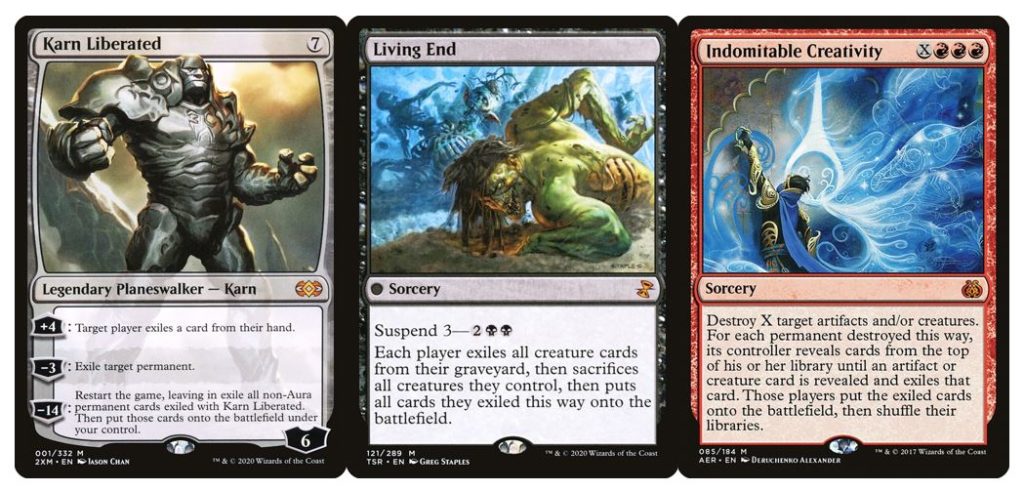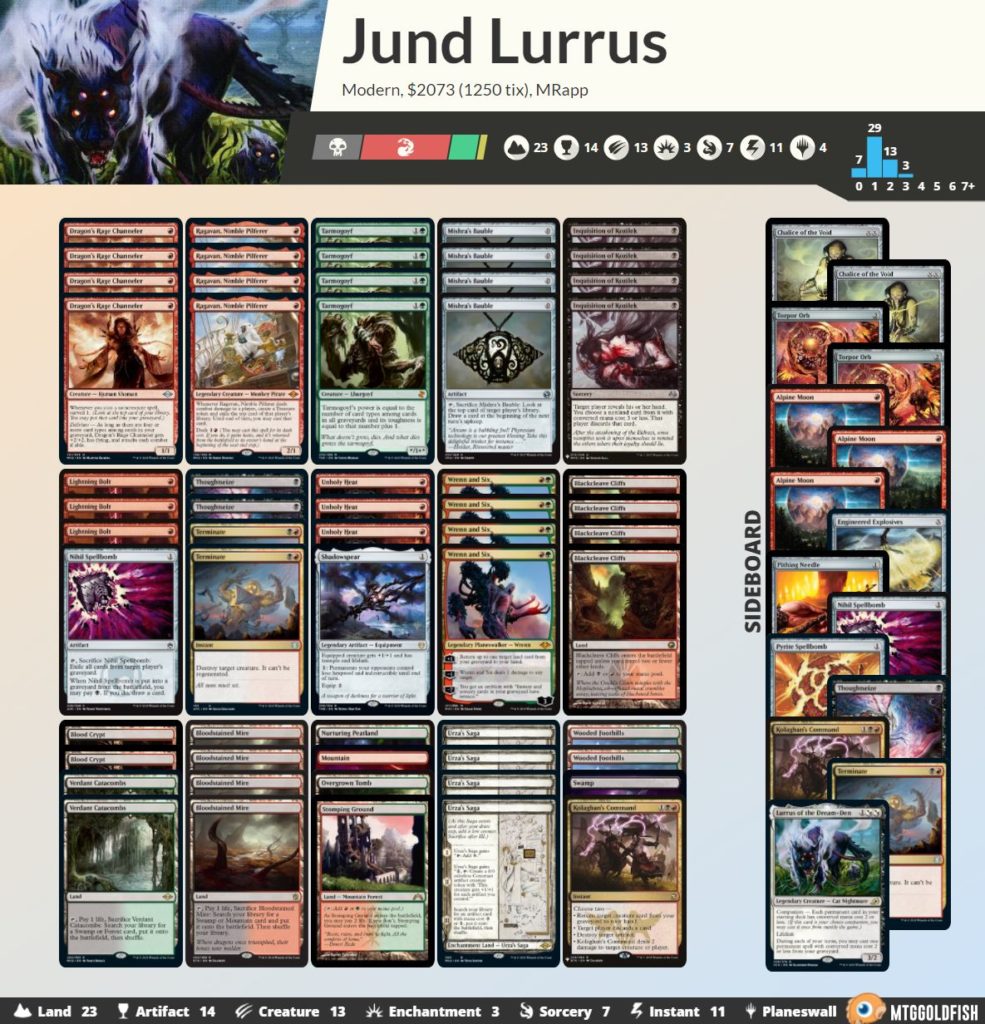Okay, okay, I get it. I can’t make fun of Jund players for being Boomers anymore, because — well, the latest version of Jund is full of new cards. It’s no secret that Jund badly needed a facelift, and what better way to do that than adding a stack of Modern Horizons 2 cards! Last weekend, Bullwinkkle6705 won a Modern Challenge with a new take on Jund, proving that you can teach an old dog new tricks.

What is Jund Saga?

Jund Saga is a low to the ground midrange deck that relies on efficiency to out-maneuver opponents. Normally, decks with a curve this low have a sizable power level drop as the game gets into the later turns. That isn’t nearly as much of an issue here, since all of your threats generate some form of card advantage.
Jund Saga does still have some things in common with Jund classic: the ability to have draws that are either grindy or high tempo. As such, the deck can easily adapt to just about any solidified metagame. Ragavan, Nimble Pilferer, Dragon’s Rage Channeler, and Tarmogoyf can all get off the line with the best of them, and when you back them up with some disruption, you can force opponents onto their heels in short order. Jund also has the Urza’s Saga, Wrenn and Six, Lurrus, and Kolaghan’s Command to grind out opponents and take over longer games.
Jund classic was built on the back of superior card quality. But over time, the Jund cards didn’t get better, while the rest of Modern did. This put Jund in an awkward spot — the deck didn’t have the most powerful or most efficient cards anymore. Being stuck in the middle meant that Jund was vulnerable to strategies that could get under it, as well as ones that went over it.
But that all changed when Modern Horizons 2 attacked. Now, Jund is sleek, shiny, and new, stuffed to the brim with powerful options. It can handle the other efficient decks, and it still has game against the bigger decks in the format.
Going Green

Unfortunately, this isn’t a section about recycling and solar panels, though I wish it were. Instead, I want to talk about the merits of adding green to Rakdos-based Lurrus decks. The biggest gain is Wrenn and Six, which is the best it has been in Modern in some time. Wrenn can pick off Ragavan, Dragon’s Rage Channeler, Snapcaster Mage and Esper Sentinel, just to name a few, while still sticking around on the battlefield. Wrenn will also make sure you almost never stumble on developing your mana. Jund Saga has excellent mana sinks later in the game, with Urza’s Saga and Lurrus, so hitting all your land drops will benefit you in the long run.
In classic Jund fashion, Tarmogoyf provides a rock solid defensive front in a format chock full of Lightning Bolts. Unholy Heat can frequently take down a Tarmogoyf, but turn-two delirium is hard to come by, and Modern is significantly lower on Fatal Push than it was before. Locking up the ground until you can set up some removal spells is exactly what Tarmogoyf wants to do. Once you have the game under control, Tarmogoyf can turn on the jets and start a relatively fast clock to end the game.
While Ancient Grudge isn’t in this list, it is a powerful option, if you want to add more cards for the Hammer Time match-up.
Strengths

Urza’s Saga has been one of the strongest cards in Modern since its release, and Jund Saga gets to combine it with another A-list card, Wrenn and Six. Two uncounterable creatures and searching for an artifact is a ton of value out of a land, and when you can just keep picking it up later in the game with Wrenn and Six, things will get out of hand for your opponent.
This package alone gives Jund Saga so much equity against Grixis Lurrus and Azorius Control, which are tough match-ups otherwise. You’ll force your opponent to have to answer continuous creatures, while you generate cards by fetching Mishra’s Bauble with the third chapter of Urza’s Saga. Decks with a curve that effectively ends at two tend to run out of gas later in the game, but Urza’s Saga gives you plenty to do with your mana; this will put a strain on your opponent’s resources until they eventually get overrun by a construct army. Additionally, Urza’s Saga will provide land, enchantment, and artifact (if you get Mishra’s Bauble) card types for delirium, which makes Dragon’s Rage Channeler and Tarmogoyf even stronger!
Dragon’s Rage Channeler + Ragavan mirrors are where Jund Saga shines. This deck is built on the idea that winning the board wins the game; it’s loaded with removal spells, discard, and powerful threats which will make these match-ups favorable. It helps that Jund can produce a seemingly never-ending stream of Urza’s Sagas, which the Rakdos-based Lurrus decks tend to struggle against.
Hammer Time is a favorable match-up for Jund Saga; you essentially have all the tools you need to win. Tarmogoyf and Dragon’s Rage Channeler backed up by a pile of removal is enough to get the job done most of the time. Traditionally, just trying to kill everything that Hammer Time plays isn’t a winning strategy, but if you can back it up with pressure, you have a winning recipe.
Weaknesses

Jund may have gotten a makeover, but some things don’t change in Modern. Tron is still a tough match-up for Jund players; three copies of Alpine Moon and a Pithing Needle can buy you some time to close the game, but Game One is still going to be hard.
One of the downsides that comes from playing Jund instead of Grixis in Modern is that the combo match-ups get worse. Thankfully, Indomitable Creativity is the closest thing to a popular combo deck in Modern at the moment. Creativity decks do need creatures in order to go off, so Jund has a little bit of agency in controlling that part of the game. But like all combo match-ups, you’re really leaning on discard spells and creatures to finish the game before your opponent can pull everything together.
I don’t think that either Living End or Cascading Footfalls are good match-ups for Jund, but Cascading Footfalls is certainly the better of the two. Removal spells matter more against a couple 4/4 Rhino tokens than against five huge creatures at the same time, so you’ll be able to win some of those Game Ones. Fortunately, once you get to sideboard, you’ll have access to Chalice of the Void, Engineered Explosives, Thoughtseize, and Nihil Spellbomb. This is the perfect example of how easy it is to customize Jund to target the metagame.
What I’d Play
I’ve enjoyed Jund Lurrus decks for some time, and as more people have picked them up, the decks have become more streamlined. However, I decided to change a few cards in the list above — either to target specific match-ups, or simply due to personal preference.

I felt like the deck was playing one too many lands, especially with four copies of Mishra’s Bauble and four Wrenn and Six. Ghost Quarter proved to be a bit too awkward in a three-color deck with four Urza’s Sagas, so I ended up cutting it. I was also a bit surprised to see a Jund deck with Wrenn and Six, but no copies of Nurturing Peatland. Being able to turn Wrenn into a card draw engine later in the game is powerful, for the low cost of adding just a single Nurturing Peatland. Forests didn’t feel necessary, as this deck just has Tarmogoyf and Wrenn and Six as the only green cards, and Blood Moon isn’t much of a consideration on that front, either.
In the removal suite, I swapped an Unholy Heat for a Lightning Bolt. I wanted to take a slightly more proactive stance with this build, to help out the aggressive Ragavan and DRC starts.
While having a suite of artifacts to tutor with Urza’s Saga adds flexibility, I found that they were taking the place of other cards I’d rather have. Expedition Map is good in prolonging games to get more copies of Urza’s Saga, but I found that Jund has enough to do later in the game already. I added a Kolaghan’s Command in its place to preserve the deck’s grindiness, and to be able to answer Chalice of the Void, Ensnaring Bridge, and Colossus Hammer.
Pithing Needle and Pyrite Spellbomb are nice to have access to in the 75, but I didn’t find it necessary to have them in the main deck, so I moved them to the sideboard. In their place, I added two copies of Terminate to have Game One outs to Murktide Regent and Death’s Shadow.
I also was surprised to see an Urza’s Saga list without a Shadowspear to fetch. After I had moved around the rest of the artifact package, I found room for one. If you put Shadowspear on a Construct token or a Tarmogoyf, it’ll be nearly impossible for your opponent to win a damage race.
Conclusion
For years, I was a Jund mage, before I fell in love with the brutal efficiency of Death’s Shadow. Needless to say, I’m thrilled that Jund has become efficient and tempo-oriented again. If you’re a Jund player of the past, or if you enjoy Death’s Shadow decks as much as I do, I think you’ll want to give this deck a try!
As always, you can find me on Twitter at @RappaciousOne for any questions or comments. Just remember, when in doubt, Jund ‘em out!

Michael Rapp is a Modern specialist who favors Thoughtseize decks. Magic sates his desire for competition and constant improvement.

